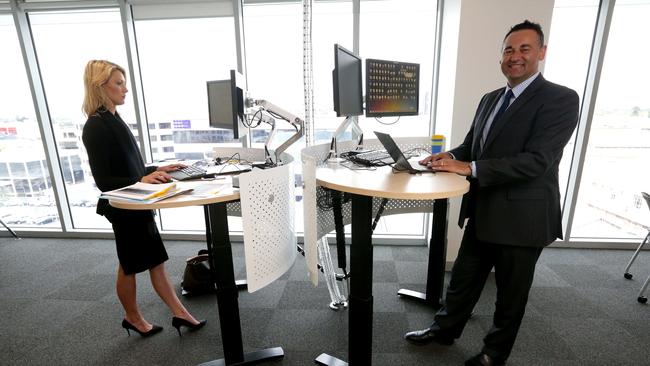Office planning: it’s a brave new hot-desk world
Love it or loathe it, hot-desking and working in collaborative spaces represents the future for offices.

Love it or loathe it, hot-desking and working in collaborative spaces represents the future for office refits around the nation.
Hot-desking allows companies to save space, less infrastructure is needed, it is cheaper to maintain, and human resources representatives increasingly say it allows for more collaborative working and increased productivity.
Last week KPMG opened its reconfigured Adelaide office, after spending $7 million to take down internal walls, create shared spaces, add a kitchen, upright desks and open hubs. The inviting smell of coffee now wafts through their middle floor.
Adelaide’s two staff floors, which 220 people share, have been divided into three spaces, dubbed focus, spark and collaborate.
KPMG’s national head of people, performance and culture Susan Ferrier says focus is the workspace where staff go to have peace and quiet — phone calls are not allowed, talk is quiet, partitions are high and there is greenery to provide privacy.
“It’s self-policing,” Ferrier says. “I made the mistake of sitting in one of our other focus areas and someone came to me and told me I was talking too loudly. And you’re not supposed to stay in the one workspace if you’re collaborating. You go into that zone.”
The spark space has been designed to encourage innovation and loud, creative idea generation.
In the collaboration space, people are encouraged to work together in groups, on lounges, at stand-up desks or around the coffee machine.
The one rule is that people must pack up their daily desk if they are going to be away from it for more than four hours. You cannot anchor a site for a day.
It may take some getting used to, moving around for peace and quiet and to talk to people, but Ferrier says communication improves when there is movement and interaction.
“People are more social, they bump into each other a lot more,” Ferrier says.
“There’s research that shows that if people bump into each other relationships expand and deepen and ideas come out if you’re standing at the coffee machine or you’re sitting on a sofa.”
The theory goes that the modern workspace should no longer define the worker, whether it be the corner office people covet, the messy desk strewn with family photos or the open-plan cubicle ranking the lowly and graduates.
Santos chief executive David Knox no longer has an office, and it is common to see what used to be rarely seen management in other companies now regularly wandering the floors.
But many workers, especially those who have been with a company for several years, feel comfortable in their own nests, surrounded by piles of papers and files, with notes stuck to monitors and mementos next to phones.
Nesting has been found in some cases to enhance wellbeing and allow a person to create a sense of security.
At KPMG the office appears almost sterile because people store their belongings in a big, black locker, accessed morning, noon and night.
Marketing manager Louisa Zeralla says she gets around the forced mobility and lack of permanent space by “carrying a large handbag” and leaving it at her temporary desk, and packing up her things regularly. In her locker she keeps a pencil case, folders, shoes and a coffee cup.
Staff are encouraged to use family photos as screen savers on their computers and to personalise their lockers.
“What’s potentially replaced that is people feel a deeper connection to each other, they’re much more vibrant, more human, it’s a real factor that’s overcoming the lack of nesting,” Ferrier says.
But this is the modern workplace, and KPMG South Australia chairman Con Tragakis says leaders now change desks and spend more time with staff. Their personal assistants also float.
“It has freed up an enormous amount of space,” Tragakis says.
That means every worker can have a window view if they choose. And without offices and walls blocking windows, light flows.
“I work here, I work upstairs, I work downstairs, in summer I’ll be working on the balcony. Agility as a concept is a non-negotiable.”
Tragakis says staff send fewer emails because they see each other more and the workspace is less formal.
“We had a 30 per cent productivity improvement since the beginning of June, when we opened the space,” he says.
The office has all the mod cons: Wi-Fi, offices where people can Skype clients, and a telepresence room that links boardrooms as if people were sitting opposite each other. The spaces promote online conversations to avoid forcing people to travel interstate.
The site is also 90 per cent paperless, with rooms of documents converted to electronic data. There is even an airport-style lounge for KPMG clients to use when in the city, gratis.
Spaces have been named after South Australian highlights, which Tragakis says connects the office and its people to the state. There are Festival, Fringe, Light and Mukarta rooms. KPMG supports local artists and their work adorns walls.
While it all sounds very progressive, there are downsides. Workmates can be scattered. And germs can spread.
Rubbery statistics show the average keyboard carriers 60 times more germs than a toilet seat — because toilet seats are cleaned regularly — and that can be avoided by people using personal laptops or devices. Germs are carried by people when they share desks. The Australian Medical Association says if people come to work when sick, they can avoid spreading germs if they sit at a desk with a 1m quarantine zone around the worker. With hot-desking you lose your 1m bubble.
But Tragakis praises the productivity increase and says staff are happier. KPMG will open similar offices in Sydney and Melbourne soon.


